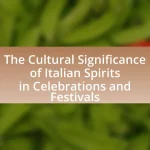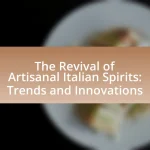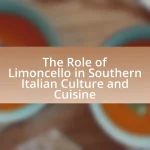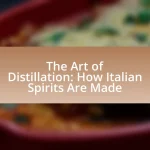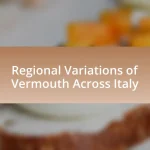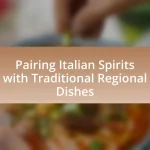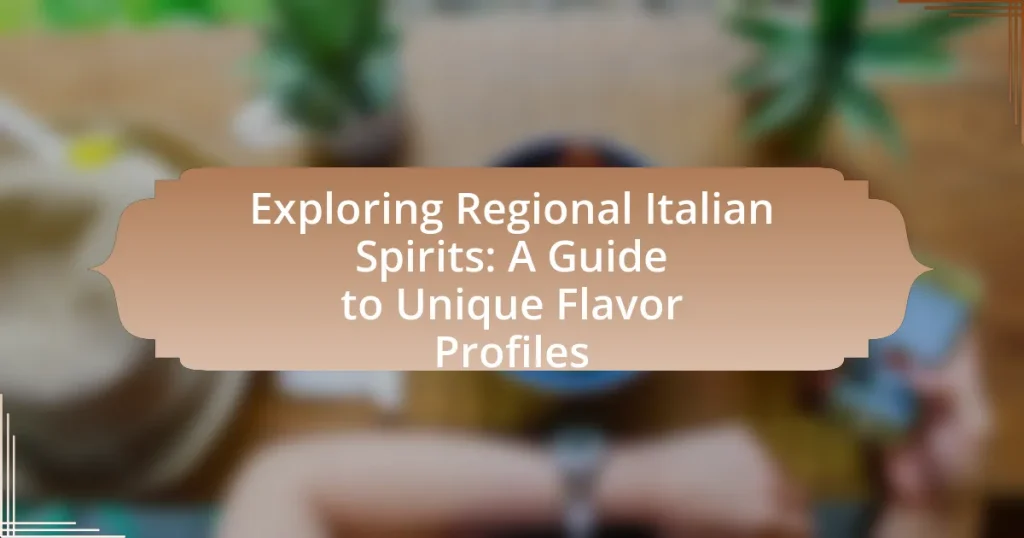Regional Italian spirits are alcoholic beverages produced in specific areas of Italy, each showcasing local culture, ingredients, and traditions. This article explores various types of these spirits, including grappa, limoncello, and amaro, highlighting their unique flavor profiles influenced by local botanicals and production methods. It discusses how regional ingredients affect taste, the cultural significance of these spirits, and the importance of exploring their diversity. Additionally, the article provides insights into tasting practices, food pairings, and resources for further learning about these distinctive Italian beverages.
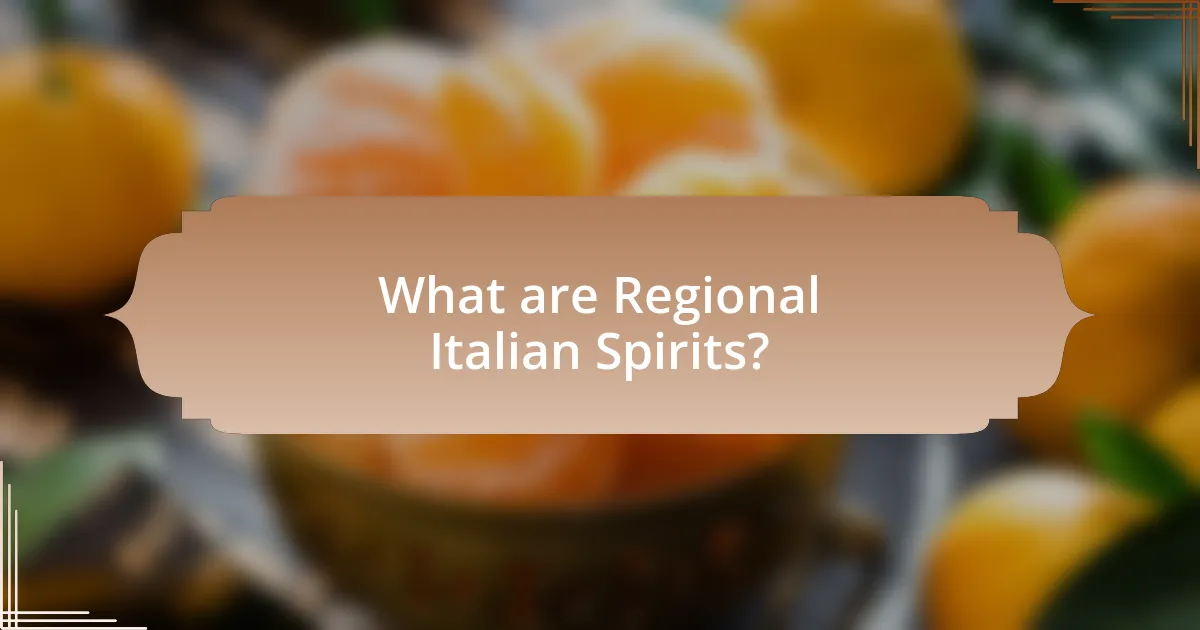
What are Regional Italian Spirits?
Regional Italian spirits are alcoholic beverages that are produced in specific regions of Italy, each reflecting the local culture, ingredients, and traditions. These spirits include a variety of products such as grappa from the northern regions, limoncello from the Amalfi Coast, and amaro from various areas, showcasing unique flavor profiles influenced by local botanicals and production methods. For instance, grappa is made from the pomace of grapes, while limoncello is crafted using lemons, highlighting the distinct agricultural products of their respective regions.
How do Regional Italian Spirits differ from other spirits?
Regional Italian spirits differ from other spirits primarily due to their unique production methods, local ingredients, and distinct flavor profiles that reflect the diverse regions of Italy. For instance, spirits like Grappa are made from grape pomace, a byproduct of winemaking, while Limoncello is crafted from local lemons, particularly in the Amalfi Coast region. These spirits often incorporate traditional recipes passed down through generations, emphasizing regional characteristics. Additionally, the use of local herbs, fruits, and spices in spirits such as Amaro showcases the specific terroir and cultural influences of each area, setting them apart from more generic spirits produced elsewhere.
What defines the unique characteristics of Regional Italian Spirits?
Regional Italian spirits are defined by their distinct flavor profiles, which are influenced by local ingredients, traditional production methods, and regional cultural practices. Each region in Italy utilizes native botanicals, fruits, and grains, resulting in a diverse array of spirits such as grappa from the north, limoncello from the south, and amaro from various areas. For example, the use of Sorrento lemons in limoncello provides a bright, citrusy flavor unique to that region. Additionally, the production techniques, such as distillation methods and aging processes, vary significantly across regions, further contributing to the uniqueness of each spirit. This regional specificity is rooted in Italy’s rich agricultural heritage and culinary traditions, making each spirit a reflection of its geographical and cultural context.
How do local ingredients influence the flavor profiles of these spirits?
Local ingredients significantly influence the flavor profiles of Italian spirits by imparting unique characteristics that reflect the region’s terroir. For instance, the use of locally sourced herbs, fruits, and grains in the production of spirits like grappa or limoncello results in distinct flavors that are emblematic of their geographic origins. In regions like Amalfi, the lemons used in limoncello provide a bright, zesty flavor, while in the Piedmont region, the use of local grapes in grappa contributes to a rich, complex profile. This connection between local ingredients and flavor is supported by the tradition of using indigenous botanicals in spirits, which enhances their authenticity and regional identity.
Why is it important to explore Regional Italian Spirits?
Exploring Regional Italian Spirits is important because it reveals the diverse cultural heritage and unique flavor profiles of Italy’s various regions. Each region produces distinct spirits that reflect local ingredients, traditions, and craftsmanship, such as grappa from the north and limoncello from the south. Understanding these regional variations enhances appreciation for Italy’s culinary landscape and promotes the preservation of traditional production methods, which are often rooted in centuries of history. For instance, the production of amaro, a herbal liqueur, varies significantly across regions, showcasing local botanicals and recipes that contribute to Italy’s rich gastronomic identity.
What cultural significance do these spirits hold in Italy?
The spirits of Italy hold significant cultural importance as they are deeply intertwined with regional traditions, culinary practices, and social rituals. For instance, grappa, a popular Italian spirit, is often consumed after meals to aid digestion and is a symbol of Italian hospitality. Additionally, spirits like limoncello are closely associated with the Amalfi Coast and are traditionally made using local lemons, reflecting the region’s agricultural heritage. These spirits not only enhance the dining experience but also serve as a means of preserving local customs and fostering community connections, as seen in festivals celebrating their production.
How do Regional Italian Spirits reflect the diversity of Italian regions?
Regional Italian spirits reflect the diversity of Italian regions through their unique ingredients, production methods, and cultural significance. Each region utilizes local botanicals, fruits, and grains, resulting in distinct flavor profiles; for example, grappa from the northern regions is made from grape pomace, while limoncello from Campania is crafted from local lemons. Additionally, traditional distillation techniques vary, with some regions favoring artisanal methods that have been passed down through generations, showcasing local heritage. The geographical and climatic conditions also influence the characteristics of these spirits, such as the use of alpine herbs in the north versus citrus fruits in the south. This regional specificity not only highlights the rich agricultural diversity of Italy but also reflects the cultural identities and traditions of each area, making Italian spirits a true representation of the country’s regional diversity.
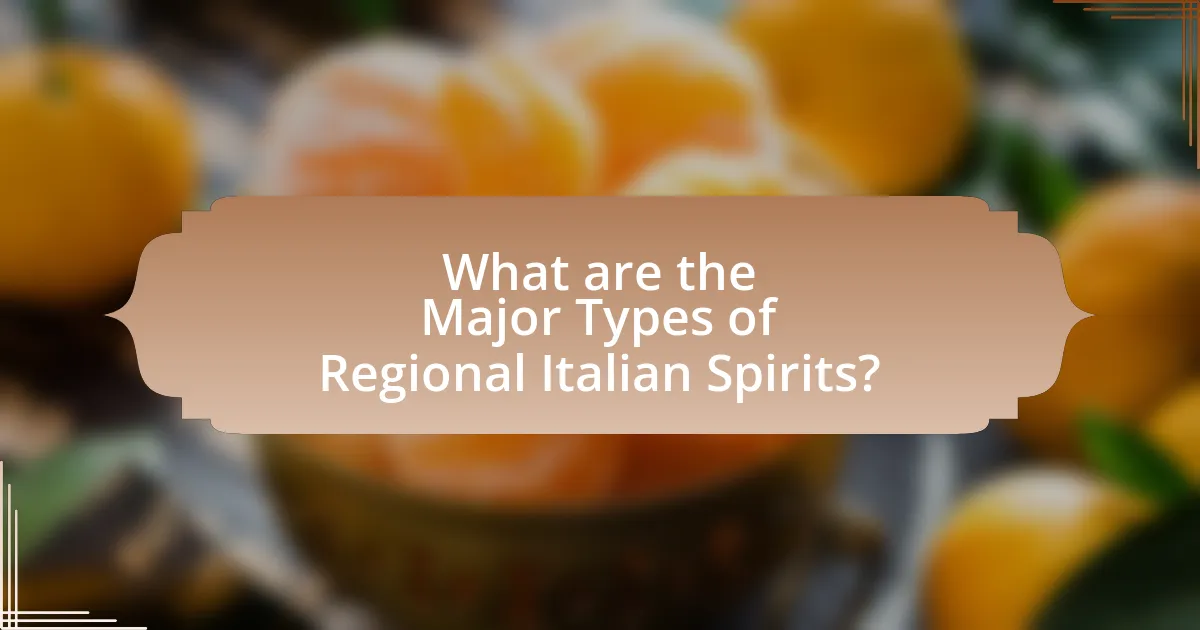
What are the Major Types of Regional Italian Spirits?
The major types of regional Italian spirits include Grappa, Limoncello, Amaro, and Vermouth. Grappa is a pomace brandy originating from Northern Italy, made from the leftover grape skins, seeds, and stems after winemaking. Limoncello, a lemon liqueur from the Amalfi Coast, is known for its sweet and tangy flavor, typically enjoyed as a digestif. Amaro, a bitter herbal liqueur, varies by region, with each producer using unique blends of herbs, roots, and spices, making it a staple in Italian culture. Vermouth, a fortified wine flavored with botanicals, has roots in Turin and is essential in classic cocktails. Each of these spirits reflects the local ingredients and traditions of their respective regions, showcasing Italy’s diverse culinary heritage.
What are the most popular types of Regional Italian Spirits?
The most popular types of regional Italian spirits include Grappa, Limoncello, Amaro, and Fernet. Grappa, a pomace brandy, is widely produced in northern Italy, particularly in regions like Piedmont and Veneto, and is known for its strong flavor derived from grape skins. Limoncello, a lemon liqueur, originates from the Amalfi Coast and is celebrated for its refreshing citrus taste. Amaro, a bitter herbal liqueur, varies by region, with notable varieties like Amaro Averna from Sicily and Amaro Montenegro from Emilia-Romagna, each offering unique flavor profiles influenced by local botanicals. Fernet, particularly Fernet-Branca from Milan, is a bitter spirit often consumed as a digestif, recognized for its complex blend of herbs and spices. These spirits reflect Italy’s diverse regional traditions and ingredients, making them integral to the country’s culinary heritage.
How is Grappa made and what are its flavor notes?
Grappa is made through the distillation of pomace, which is the leftover grape skins, seeds, and stems after winemaking. The process begins with fermenting the pomace, followed by distillation in pot stills or column stills, where the alcohol is extracted. The resulting spirit is typically aged in wooden barrels, which can impart additional flavors.
Flavor notes of Grappa vary widely depending on the grape variety used and the distillation process. Common flavor profiles include fruity notes such as pear, apple, or citrus, alongside herbal and floral undertones. Some Grappas may exhibit a spicy or earthy character, influenced by the aging process and the type of wood used for maturation.
What distinguishes Amaro from other Italian liqueurs?
Amaro is distinguished from other Italian liqueurs primarily by its complex blend of bitter and herbal flavors, which are derived from a variety of botanicals, roots, and spices. Unlike sweeter liqueurs such as limoncello or sambuca, Amaro typically has a more pronounced bitterness, making it unique in the Italian liqueur landscape. The production process often involves macerating these botanicals in alcohol, followed by aging, which enhances its depth and character. Additionally, Amaro varies significantly by region, with each variant reflecting local ingredients and traditions, such as Amaro Averna from Sicily or Amaro Montenegro from Emilia-Romagna, further setting it apart from other Italian liqueurs.
How do different regions influence the types of spirits produced?
Different regions influence the types of spirits produced by varying local ingredients, climate conditions, and traditional production methods. For instance, in Italy, the use of specific grapes in Tuscany leads to the production of high-quality grappa, while the abundance of citrus fruits in the Amalfi Coast results in limoncello. Additionally, the cooler climate in the northern regions supports the production of herbal liqueurs like Fernet, which are less common in warmer areas. Historical practices and regional regulations also shape the distinct characteristics of spirits, such as the aging processes in barrels made from local woods, which impart unique flavors.
What are the key spirits from Northern Italy?
The key spirits from Northern Italy include Grappa, Amaretto, and Fernet. Grappa is a pomace brandy made from the leftover grape skins, seeds, and stems after winemaking, originating from the region of Veneto and widely produced in Trentino-Alto Adige. Amaretto, a sweet almond-flavored liqueur, is primarily associated with the Lombardy region, particularly the town of Saronno. Fernet, a bitter, aromatic spirit, is often consumed as a digestif and has its roots in the region of Piedmont. These spirits are integral to Northern Italy’s cultural and culinary heritage, reflecting the region’s diverse agricultural products and traditions.
Which spirits are unique to Southern Italy?
Unique spirits to Southern Italy include Limoncello, Grappa, and Amaro. Limoncello, a lemon liqueur, originates from the Amalfi Coast and is made from Sorrento lemons, known for their intense flavor and aroma. Grappa, a pomace brandy, is produced throughout Italy but has a strong presence in Southern regions, particularly in Campania. Amaro, a bitter herbal liqueur, varies by region, with Southern Italy offering distinct local recipes that incorporate local herbs and botanicals. These spirits reflect the rich agricultural heritage and culinary traditions of Southern Italy.
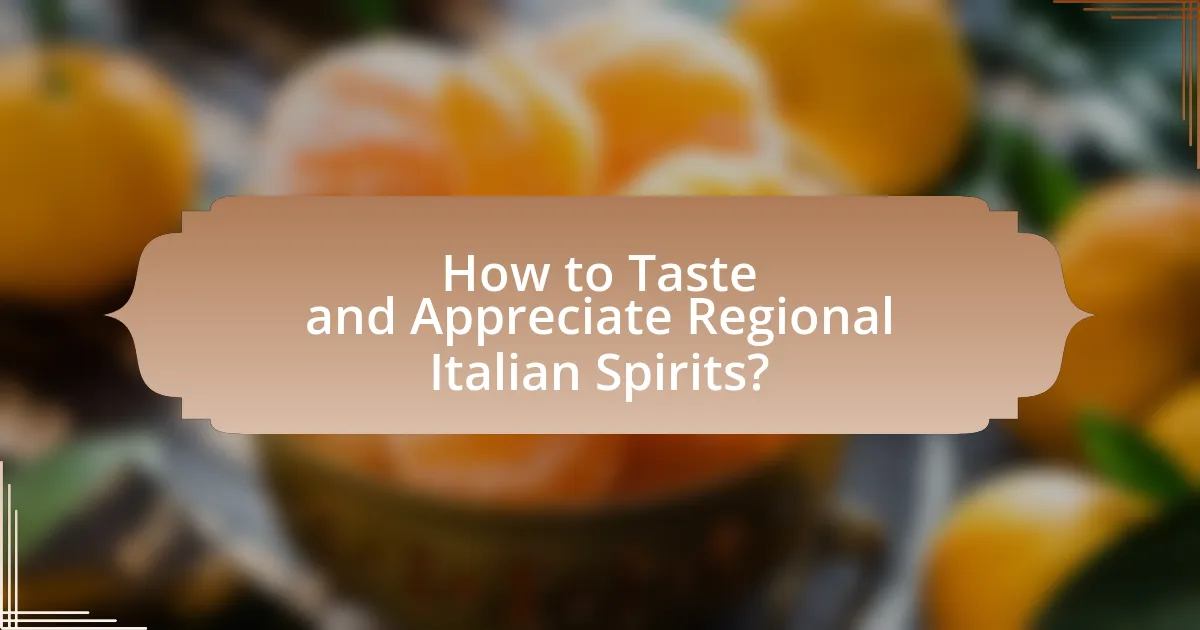
How to Taste and Appreciate Regional Italian Spirits?
To taste and appreciate regional Italian spirits, begin by selecting a specific spirit, such as grappa, amaro, or limoncello, which each have distinct flavor profiles tied to their regions. Next, observe the spirit’s appearance, noting its clarity and color, which can indicate its quality and ingredients. Swirl the glass gently to release aromas, then inhale deeply to identify the various scents, as the nose plays a crucial role in flavor perception. Take a small sip, allowing the spirit to coat your palate, and pay attention to the initial flavors, the mid-palate complexity, and the finish, which reveals the spirit’s character.
Understanding the regional context enhances appreciation; for example, grappa from the Veneto region often has floral notes, while amaro from Sicily may feature herbal and citrus flavors. This knowledge of regional characteristics, combined with mindful tasting techniques, allows for a deeper appreciation of the craftsmanship and tradition behind each spirit.
What are the best practices for tasting Regional Italian Spirits?
The best practices for tasting Regional Italian Spirits include using a clean glass, observing the color, inhaling the aroma, taking a small sip, and savoring the finish. Using a clean glass ensures that no residual flavors interfere with the tasting experience. Observing the color helps assess the spirit’s clarity and richness, which can indicate its quality and aging process. Inhaling the aroma allows the taster to identify various scent notes, which are crucial for understanding the spirit’s complexity. Taking a small sip enables the taster to experience the initial flavor profile, while savoring the finish reveals the lingering tastes and overall balance. These practices are essential for appreciating the unique flavor profiles of Italian spirits, such as grappa, amaro, and limoncello, which vary significantly by region and production methods.
How should one prepare for a tasting session?
To prepare for a tasting session, one should first ensure a neutral palate by avoiding strong flavors prior to the event. This includes refraining from consuming spicy foods, strong cheeses, or heavily flavored snacks, as these can alter the perception of the spirits being tasted. Additionally, it is essential to gather the necessary materials, such as appropriate glassware, water for cleansing the palate, and tasting notes to document observations. Researching the specific regional Italian spirits to be tasted can enhance understanding and appreciation of their unique flavor profiles. This preparation allows for a more focused and enjoyable tasting experience, enabling participants to fully engage with the nuances of each spirit.
What are the common tasting notes to look for?
Common tasting notes to look for in Italian spirits include herbal, citrus, floral, and fruity flavors. These notes often reflect the regional ingredients and production methods used in crafting the spirits. For example, amaro typically features a blend of bitter herbs and spices, while limoncello showcases bright lemon zest and sweetness. The presence of these tasting notes can be attributed to the diverse botanicals and fruits native to Italy, which contribute to the unique flavor profiles of each spirit.
How can food pairings enhance the experience of Regional Italian Spirits?
Food pairings can significantly enhance the experience of Regional Italian Spirits by complementing and elevating their unique flavor profiles. For instance, pairing a robust Amaro with rich, savory dishes like braised meats can highlight the herbal and bitter notes of the spirit, creating a harmonious balance. Additionally, regional spirits such as Grappa can be enjoyed with local cheeses, where the creamy texture and saltiness of the cheese enhance the spirit’s aromatic complexity. Historical practices in Italy show that traditional food and spirit pairings have been developed to maximize flavor interactions, making the overall tasting experience more enjoyable and memorable.
What dishes complement Grappa and Amaro?
Grappa and Amaro are complemented by rich, savory dishes such as aged cheeses, charcuterie, and hearty pasta dishes. Aged cheeses like Parmigiano-Reggiano enhance the herbal notes of Amaro, while charcuterie provides a salty contrast that balances Grappa’s intensity. Hearty pasta dishes, particularly those with robust sauces, also pair well, as their flavors harmonize with the complexity of both spirits. These pairings are rooted in Italian culinary traditions, where the balance of flavors is essential for a complete dining experience.
How do regional cuisines influence spirit pairings?
Regional cuisines significantly influence spirit pairings by aligning the flavors and ingredients of local dishes with complementary alcoholic beverages. For instance, in Italy, the use of fresh herbs, tomatoes, and seafood in coastal cuisines pairs well with lighter spirits like limoncello or grappa, which enhance the dish’s freshness. Conversely, richer, meat-based dishes from regions like Tuscany often pair with robust wines or aged spirits, such as Chianti or Vin Santo, which can stand up to the intense flavors. This pairing practice is rooted in historical traditions and local agricultural practices, where the availability of specific ingredients shaped both culinary and distillation methods, creating a harmonious relationship between food and drink.
What tips can enhance your exploration of Regional Italian Spirits?
To enhance your exploration of Regional Italian Spirits, focus on tasting a variety of local products from different regions, as each area has unique ingredients and production methods that influence flavor. For instance, Grappa from the northern regions often has a different profile compared to Limoncello from the south, showcasing the diversity of Italian terroir. Additionally, visiting distilleries and engaging with local producers can provide insights into traditional crafting techniques and the history behind each spirit, enriching your understanding and appreciation. Exploring regional festivals dedicated to these spirits can also offer opportunities to sample rare varieties and learn from experts in the field.
How to select the best Regional Italian Spirits for your collection?
To select the best Regional Italian Spirits for your collection, focus on identifying unique flavor profiles and regional characteristics. Italian spirits such as Grappa, Amaro, and Limoncello vary significantly by region, with Grappa originating from the northern regions like Piedmont and Veneto, while Limoncello is primarily produced in Campania. Research the production methods, local ingredients, and historical significance of each spirit to ensure authenticity and quality. For example, high-quality Grappa is often made from specific grape varieties and distilled in small batches, reflecting the terroir of its origin. Additionally, consider seeking out artisanal producers who emphasize traditional techniques, as these spirits often offer a more genuine taste of their region.
What resources are available for learning more about these spirits?
Books, online courses, and tasting events are valuable resources for learning more about regional Italian spirits. Notable books include “The New Italian Bar” by Marco Pierini, which covers various Italian spirits and their uses in cocktails, and “Amaro: The Spirited World of Bittersweet, Herbal Liqueurs” by Brad Thomas Parsons, focusing on the amaro category. Online platforms like MasterClass offer courses on Italian mixology, providing insights into the history and production of these spirits. Additionally, local distilleries often host tasting events and workshops, allowing participants to experience the flavors firsthand and gain knowledge from experts in the field.
